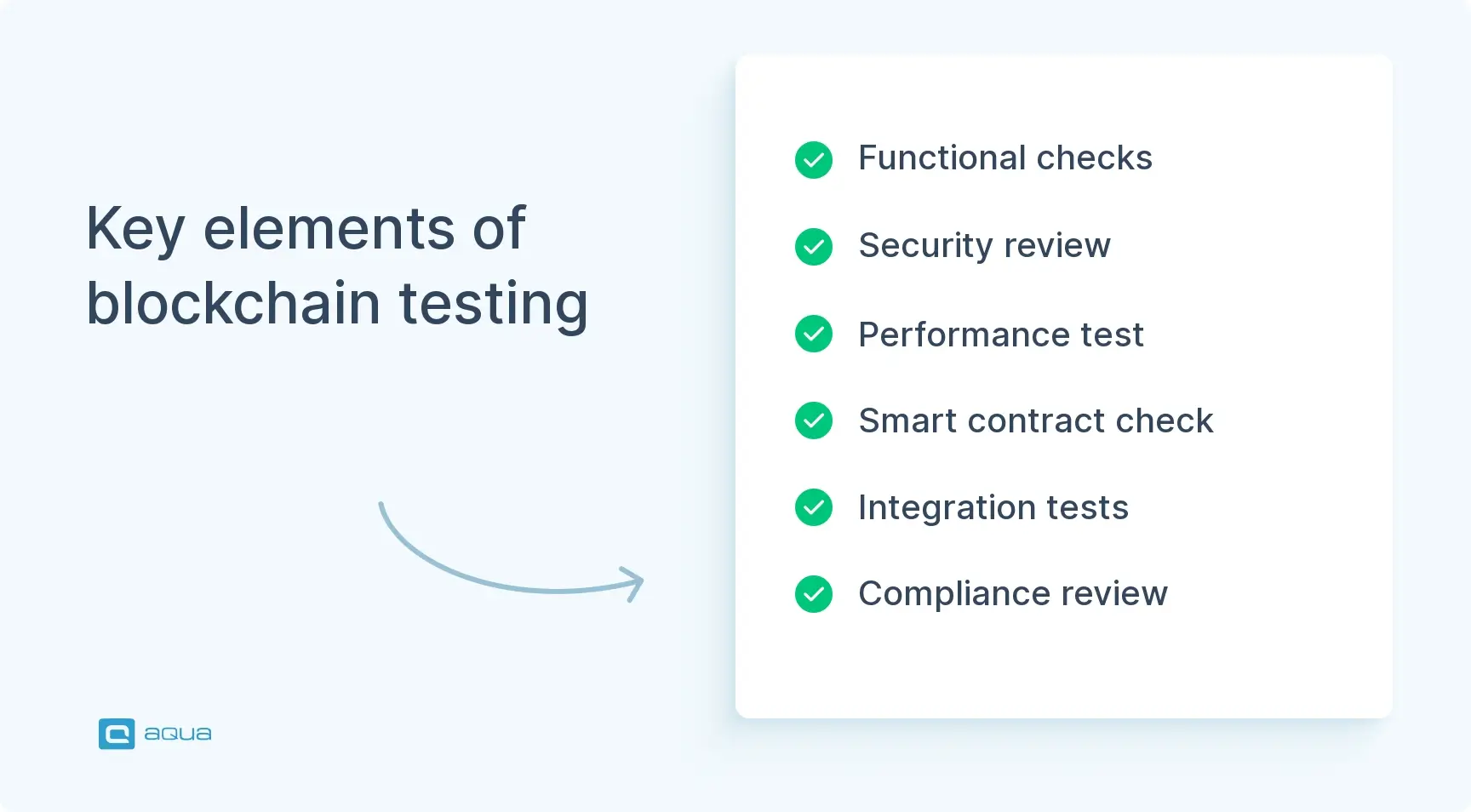What is a blockchain testing strategy?
Blockchain testing strategy involves a set of planned approaches and methodologies to ensure blockchain-based applications or systems’ reliability, security, and functionality. This strategy involves a series of planned testing activities aimed at identifying and mitigating potential risks, ensuring the integrity of transactions, and verifying the overall performance of the blockchain network.
Key elements of blockchain testing strategy
Key elements of a blockchain testing strategy include:
- Functional Testing involves validating the core functionality of the blockchain system, such as transaction processing, data storage, and consensus mechanisms. It ensures that the blockchain network operates as expected and adheres to specified requirements.
- Security Testing is essential for identifying vulnerabilities and weaknesses in the blockchain infrastructure, including potential attack vectors, cryptographic flaws, and unauthorised access points. By conducting security testing, you can safeguard sensitive data, protect against cyber threats, and maintain the integrity of the blockchain network.
- Performance Testing evaluates the blockchain network’s scalability, throughput, and latency under various conditions, such as high transaction volumes and network congestion. Performance testing helps identify bottlenecks, optimise resource allocation, and ensure that the blockchain system can handle the expected workload efficiently.
- Smart Contract Testing: You’ll want to flip your testing approach upside down. Write those tests before you even touch the contract code. This TDD mindset catches nearly 60% more bugs early on. Start with fuzz testing by throwing random data at your contracts to see what breaks. Then define your invariants. Those non-negotiable rules that should never fail, no matter what. Don’t forget the obvious stuff that trips up seasoned developers: always test permission boundaries and poke around for reentrancy attacks. Front-running vulnerabilities love to hide in plain sight.
- Integration Testing involves testing the interoperability and compatibility of the blockchain system with external components, such as third-party applications, APIs, and legacy systems. It ensures seamless communication and data exchange between different systems within the blockchain ecosystem.
- Regulatory Compliance Testing ensures that the blockchain solution complies with relevant laws, regulations, and industry standards, such as data privacy regulations (e.g., GDPR) and financial regulations (e.g., KYC/AML). It helps mitigate legal risks and ensures the blockchain solution meets regulatory requirements.
Your blockchain testing approach needs depth across every level – smart contract fuzzing catches edge cases that manual testing misses, while mainnet forking lets you poke around with real network conditions without the risk. Don’t skip performance stress tests either; they’ll reveal bottlenecks before your users do.
Start with fuzzing your core contracts first – it’s where nearly 80% of critical vulnerabilities hide. Most teams jump straight to integration testing and miss these foundational cracks.
This strategy future-proofs your entire solution as blockchain standards keep shifting.

Draft your blockchain testing strategy early
Even for small-scale effort, efficient quality assurance does not happen without a game plan. In fact, it could be even more important to avoid wasting effort in a very chaotic manner. You won’t save time by rushing this stage at all.
There is a separate reason why you should be smart about your blockchain testing, one your team may have not encountered in other industries. From elections to trading, blockchain transactions are valued for being transparent and immutable. Any mistake that leads to erroneous entries into the blockchain means a dirty hack or separate functionality to work around incorrect submissions. This extra work hurts smaller projects the most.
Our QA engineer Anton Chadin reminds about another caveat of testing something irreversible:

‘Data is not deleted from the chain either. If your company follows the GDPR, testers need to be careful about which data is stored. In general, you need to be extra cautious about not using sensitive information in tests’.
Luckily, the decades of lessons learned from making testing strategies apply to blockchain as well. Things become even easier if your company already has some high-level test documentation to guide you around general goals and universal practices. If that is the case, you will actually be making a simple test plain and not a testing strategy.
The variety of testing strategies deserves a separate article. We happen to have one right here. Don’t open it unless you would like to find the 6 key types of testing strategies.
Pick your foundation wisely
As you were building testing strategy for blockchain, you certainly realised there are technology-specific user stories that require some extra work before they can be tested. Luckily, the blockchain enthusiasts’ preference for wide availability extends to development and QA solutions as well. Here are a few suggestions:
- Hyperledger Fabric is an application framework designed specifically for bringing business people into development. It provides solid support for automated testing, including unit tests that significantly reduce the actual QA effort.
- Populus is another QA-friendly solution for developing Ethereum-based projects. It enables test automation with Python and mixes smart contract testing with a universal and widespread pytest QA framework.
- Alternatively, Ethereum Tester is a dedicated QA solution that you can use for blockchain projects made elsewhere. It comes with APIs for forking out-of-the-box and even mining if your product happens to have a mineable coin.
The pros and cons here go beyond developers’ and testers’ convenience:

‘The performance of blockchain applications is tied to the performance of individual blockchain components. Your solution will run as fast as the slowest component does. The potential latency that comes from one underperforming piece should be considered for both development and QA’.
When you pick a development environment for blockchain products, remember that your testing is not limited to specialised software. Most of the automated testing can be done with general test automation tools that you may integrate into the project.
Latest Blockchain Testing Tools and Automation Frameworks
The blockchain testing world is packed with tools that’ll actually make your QA process stronger. For smart contract work, Hardhat and Foundry are solid picks – they come with mainnet forking and fuzzing capabilities that catch issues you might miss otherwise. Ganache and Anvil spin up local blockchain nodes fast, perfect when you need to prototype quickly. Truffle handles full-stack Ethereum development nicely. Security-wise, Slither and Mythril run static analysis to spot vulnerabilities before they become headaches.
For end-to-end DApp testing, throw Cypress together with Synpress, and you can automate wallet interactions without the manual clicking. Your toolset needs to match both your blockchain platform AND your project’s specific needs. Start by mapping out your testing pipeline from development through deployment, then pick tools that give you clear reporting on code quality, gas usage, and test coverage. Companies using this systematic approach report nearly 40% fewer production bugs.
Choose the right test management tool
All the tests and the defects that you find with them should be stored somewhere. Powering QA with Excel would be at the very least inconsistent if you’re making a disruptive Web 3.0 solution. You need a separate tool with some street credibility and the flexibility to push new heights.
Generally, the choice comes down to test management tools and application lifecycle management (ALM) solutions. The latter are all-in-one hubs that help you carry out the entire project, from requirements and development to software testing. Why juggle 4 tools (including a separate requirements management tool) when you can use just one?
When picking your solution, one piece of advice would be to think long-term. The ideal candidate should have simple migration to get data in and out. More importantly, it should not be a sealed box that relies on the developer for support. You need to be able to build custom integrations with third-party software yourself.
Integrations-friendly ALM for customised blockchain testing
Incorporate specialised tests
Whether it’s an on-premise or web-based blockchain app, the strategy for testing will require some specialised tests. Both the QA lead and their colleagues will have to do some extra research unless they have done blockchain testing before.
Ultimately, hands-on blockchain testing comes down to block generation and transaction processing. You need to verify that nodes receive data correctly and in chronological order. The blockchain integrity should not be affected by individual nodes temporarily losing connection to the network. Naturally, the blockchain access permissions should be on point to avoid malicious actors ruining your solution.
Blockchain-specific tests should not tempt you to neglect the overall user experience and other functionality. The fact that Samsung has a robust blockchain backend for their NFT store does not mean much to users if the actual marketplace is too messy.
Best Practices and Common Edge Cases in Blockchain QA
Your blockchain QA strategy needs these battle-tested practices to actually work when it counts. Jump straight into test-driven development: write your test cases before you build, covering the scary stuff like reentrancy attacks, oracle manipulation, and what happens when the network gets slammed.
Simulate mainnet conditions early, especially during high-stress events like mass airdrops, where gas fees spike and transactions pile up. Throw in regression testing after every update (this catches nearly 40% of issues that slip through), plus invariant and fuzz tests to find the bugs hiding in unexpected places.
Remember, user permission boundaries break more often than you’d think. Test those access controls like your reputation depends on it. Keep sensitive data off-chain when compliance is involved, and get your testers talking to blockchain experts regularly. They’ll spot adversarial behaviours your standard QA process won’t catch. Stick to these practices and your blockchain solution stays solid not just at launch, but through every update that follows. (Source: LambdaTest, research 2025)
Conclusion
A successful blockchain testing strategy is a mix of three things. You put effort into planning, you respect the specifics of testing a blockchain solution, and you don’t neglect other aspects of your solution. Follow these rules and to the moon you go.
Most flexible ALM for all blockchain-testing needs


















